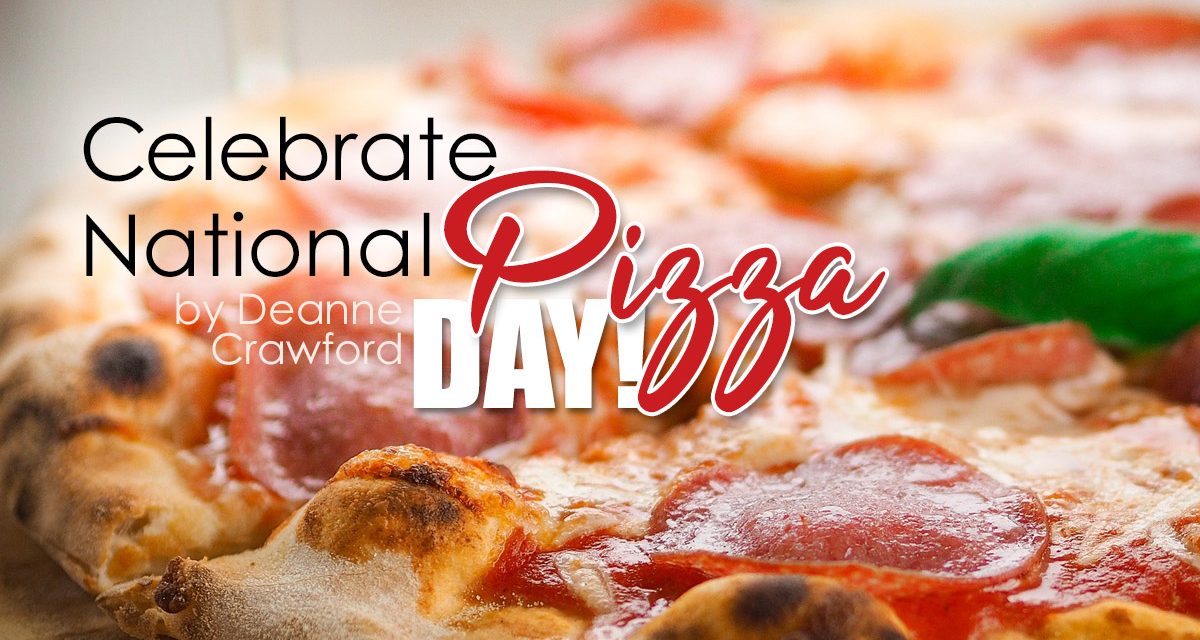Many people consider it to be the perfect food, blending all the food groups. But it also has a reputation for being a diet buster because of the salt and fat content. Pizza is beloved by people across the world for its versatility and low-cost preparation. After all, where else can you feed a family of 6 for under $50?
Without further ado, gather your children and celebrate National Pizza Day (February 9th) by learning a little more about the wildly popular food and finish the day creating a pie together through one of included recipe links.
The origin of the word pizza is uncertain. Considered to be the birth place of modern pizza, Italy defines the word as pie. It may, however, have roots in Latin (pix ‘pitch’) or Greek (pitta). The history of pizza dates to ancient civilizations. The earliest form of pizza was a flatbread cooked beneath heated stones and topped with common ingredients. It is thought that ancient Greeks topped a flat round bread with assorted toppings and considered it an edible plate. This was considered a thrifty, convenient food mostly consumed by the working class. Children may be surprised to learn that soldiers in 6th century BC baked a type of flatbread pizza on their shields. Evidence of a widely eaten flat cake and tools of the pizzeria trade were found in the ashes of Mount Vesuvius in Pompeii (Want to learn more about Mount Vesuvius? Check out this free unit study!). While the first American pizza parlor opened in New York City in 1905, it wasn’t until soldiers returned home after World War 2 that pizza’s popularity spread across the U.S., England, France and Spain. It is thought that European and American soldiers developed an appetite for the new dish while occupying Italian territory during the war. What’s Cooking America offers fascinating highlights into pizza’s history. Younger children will enjoy this short animated video history.
The pizza we enjoy today has roots in the city of Naples in southern Italy. Introduce this beautiful country at National Geo Kids. In 1889 a pizza maker created a pizza with the colors of the Italian flag for Queen Margherita. Tomatoes (red), mozzarella (white) and basil (green) remain the foundational ingredients in Italian style pizzas. Would you be surprised to learn the regional pizzas that are popular across the United States have garnered worldwide attention? This is so true that if you travel to Europe, and lack adventure in trying new cuisines, it is possible to enjoy a traditional New York slice or a Chicago style thick pie. How Stuff Works explains the different types of pizzas popular in the United States.
Consider the 3 styles that children may be familiar with: New York, Chicago and California styles. The original “grab and go”, the New York style pizza has a thin, foldable crust for creating a “sandwich” to eat on the run. Toppings are limited to a thin layer of toppings that cling to the flat top shape to keep the mess factor minimized. Here is a great recipe if you would like to try a New York style pizza with your children.
Chicago style pizza, on the other hand, features a thick crust with an inch-deep smothering of tomato sauce, cheese and toppings. Cheese and toppings are often layered several inches from the bottom crust to the top of the pie. This is not a hand sized serving; it requires a plate and eating utensils to consume. Personalize this recipe if your family would like to try a hand at creating a deep-dish masterpiece.
Reminiscent of the New York or traditional Italian crust, the California pizza is set apart by its emphasis on unique toppings. Common toppings include artichoke hearts, avocado and goat cheese. More adventurous connoisseurs may add duck sausage or smoked salmon. Here is a recipe for a California BBQ Chicken recipe that may appeal to your family.
Whether you try your hand at creating one of the masterpieces above or would rather stay with the tried and true pizza your family favors, you will want to involve your children in the pizza creating activity. In the words of Guy Fieri, “Kids want to sauté, to cut the pizza, to see how the ingredients come together. If you let them do the fun stuff, they’ll develop skills and interests that will stay with them forever.” My children loved to create personal pizzas using our favorite crust recipe (or an English muffin!). This was born out of necessity the year my son decided he did not like cheese on his pizza!
What is your favorite pizza topping? Ask your children to share their favorite (be sure to share yours). Are you like the majority of Americans who rank pepperoni as their most requested topping? Or maybe they identify with the French who add a sunny side up egg to their pizza? Other toppings that our palates may consider unusual include Russian sardines, tuna and/or herring pizza or the mildly sweet coconut fruit found atop Costa Rican pizzas.
Our pizza study would not be complete without a quick look at mathematics. Pizza is a perfect tool for learning fractions at all ages, whether you chose a model or one fresh out of the oven! Children can even enjoy a Pizza Party game online to reinforce math concepts. Lest you think pizza fractions are only for the young, check out New Scientist Mathematician’s as they invent new ways to slice pizza into exotic shapes. Challenge your teens to see how many polygons they can carve in their dinner tonight!
Earlier, I mentioned our family favorite pizza crust recipe. While you may find this strange (many people do until they try it!), my children devoured a pizza crust made from rice and recently we have become fans of the low carbohydrate chicken crust. If your family prefers a healthier vegetable based pizza, try your hand at making cauliflower rice crust! We would love to hear your favorite pizza creations! Join us on Facebook to share. ~ Deanne
~ Voglio la pizza!





